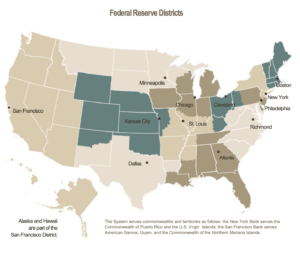Bloomberg's Leah Nylen reported Thursday that "a Colorado judge issued an order temporarily blocking the proposed $25 billion merger of Kroger Co. and Albertsons Cos., which has been challenged by…
Fed’s January Ag Economy Observations
The Federal Reserve Board on Wednesday released its January 2024 Beige Book update, a summary of commentary on current economic conditions by Federal Reserve District. While the report covers generalized “regional economic conditions and prospects,” it also includes the following observations pertaining to the U.S. agricultural economy.

Sixth District — Atlanta
“Low cattle supply led to higher cattle prices, but consumers substituting less expensive proteins prevented full pass-through of prices,” the Beige Book report said. “Domestic demand for chicken rose, but demand was down overall as cases of avian flu led to additional export restrictions and lower egg supply. Milk prices rose amid growing domestic demand for dairy, but low export levels continued to depress the market. There was little change in demand or supply for row crops, but demand for cotton remained weak.”
Seventh District — Chicago
“District net farm income was above average for 2023 according to contacts, helped by stronger than expected crop yields. However, expectations for 2024 farm income were lower.”
“District net farm income was above average for 2023 according to contacts, helped by stronger than expected crop yields,” the report said. “However, expectations for 2024 farm income were lower, as prices started the year below break-even levels for many commodities. Corn and soybean prices edged down during the reporting period while wheat prices were up a bit. Cost changes for crop production inputs were mixed. Dairy, hog, and cattle prices decreased. Egg prices were slightly higher and rising avian influenza cases led to concerns about a repeat of last winter’s large outbreak. Contacts felt District farms generally ended 2023 in strong enough financial positions to weather whatever 2024 brings.”
Eighth District — St. Louis
“Agriculture conditions have worsened slightly since our previous report, as ongoing droughts continue to effect crop and livestock conditions,” the report said. “Of the District states reporting data through the end of December, the percent of winter wheat rated as fair or better was down only two percent relative to last year. Total wheat acreage in 2023 expanded significantly compared with 2022, returning to 2021 levels.”
“While drought conditions improved slightly in Tennessee over the reporting period, the extent of moderate to severe drought increased throughout the northern areas of the District at the same time,” the report said. “Cotton and cattle farmers reported feeling the effects; some reported that they had to ship their cattle to other states as a result.”
Ninth District — Minneapolis
“District agricultural conditions were unchanged since the last report,” the report said. “Contacts across the region gave differing reports about farm incomes. Contacts generally agreed incomes were down substantially from a year ago, though some indicated they were stronger than expected.”
Tenth District — Kansas City
“Profits narrowed the past year alongside the moderation in prices, particularly in areas where yields were impacted by drought.”
“Agricultural economic conditions in the Tenth District were steady through December, but softening farm income and credit conditions remained a concern,” the report said. “Crop prices were stable over the past month, ending 2023 considerably lower than a year ago. Profits narrowed the past year alongside the moderation in prices, particularly in areas where yields were impacted by drought. Corn and soybean yields increased slightly from last year in Nebraska and parts of Kansas but remained below the five-year average in all District states. Despite some recent volatility, cattle prices were strong alongside low inventories and supported profitability for cow/calf producers. Many District contacts cited ongoing pressure from elevated production costs and higher interest rates as major factors for the outlook of the farm economy in 2024.”
Eleventh District — Dallas
“Drought conditions continued to recede, and contacts noted generally good soil moisture and an expectation for better crop production prospects this year with El Niño conditions forecasted through the spring,” the report said. “Agricultural prices were down across the board over the past six weeks. While cattle prices remained higher than a year ago, some grain prices have pulled back to two or three year lows. Contacts noted that farmers will need strong crop yields this year to make the budget work with high production costs and relatively low grain and cotton prices.”
Twelfth District — San Francisco
“Conditions in the agriculture and resource-related sectors were solid,” the report said. “Contacts reported robust yields and inventories of various products, including seafood and some permanent crops such as tree fruits. The resulting ample supply continued to hold down prices, buoying domestic demand for agricultural food products overall. International demand was strong, and exports for some crops rose.”





